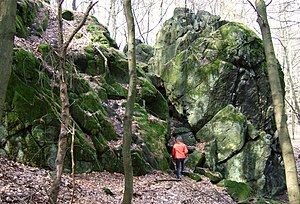Magnetic stones
|
Magnetic stones
|
||
|
Rock group in the natural monument "Magnetsteine" (2009) |
||
| location | Nieder-Beerbach , Darmstadt-Dieburg district , Hesse | |
| Geographical location | 49 ° 47 ' N , 8 ° 40' E | |
|
|
||
| Sea level | from approx. 400 to 419.7 m | |
| Setup date | May 10, 1938 | |
| particularities | Natural monument before 1932 | |
The magnetic stones are an extensive geological natural monument in the Nieder-Beerbach district , Mühltal municipality in the Darmstadt-Dieburg district in southern Hesse. The rocks in the Diallag peridotite are strikingly polar magnetic .
location
The “Magnetsteine” natural monument is located in the Frankenstein complex in the Vorderen Odenwald . This includes several cliffs and rock groups along the ridge line of the Ilbes mountain , whose highest point of 419.7 meters is marked by a trigonometric point . They were listed as natural monuments before 1932. They are protected by an ordinance of May 4, 1938, published in the Hessian State Government Gazette No. 72 of May 10, 1938.
geology
The bedrock of the magnetic stones was created around 360 million years ago. In 1888, the rocks by the geologist were Achilles Andreae and the physicist Walter King examined in detail: In Frankenstein Solid extend surrounded by lighter gabbro - diorites three trains of dark Diallag -Gesteinen. The magnetic stones belong to the northernmost, almost black-green train that is very rich in olivine . It belongs to the Wehrlites , a form of peridotite . Primarily olivine and dialag were identified as the original mixture, and serpentine and magnetite as secondary . There are often transitions to the olivine gabbro at the edge of the train.
Rock magnetism
There are different tilted field directions in the magnetic stones, the compass needle can be deflected by up to 30 °. In 1808 this magnetic anomaly was first mentioned in the article on a new magnetic mountain type in the annals of physics . Since then, the magnetic stones have been a target for geologists and mineralogists. Although it is forbidden to chop off parts of it, mineral collectors have made some of the rocks a third smaller since 1925.
The magnetization of the rocks is said to have been caused by external influences, since the rock otherwise does not differ from that in the serpentine fracture below. It is believed that strong lightning strikes magnetized the ridge. The magnetism of the rocks steadily decreases down the slope. As a result of the lightning strikes, a current flow formed in the rock and it heated up to above its Curie temperature of 570 ° C. The current magnetic field was saved ("frozen") during the cooling process.
Another form of this magnetism can be found at the southern end of the Odenwald on Katzenbuckel , a volcano - remainder in the red sandstone Odenwald on the local nephelinite - basalt .
tourism
The magnetic stones can be accessed by hiking trails from the parking lot at Frankenstein Castle . The Alemannenweg also leads along the rock groups. Some striking rocks are named, including Brohmfels, Becker-Felsen and Magnet-Stein. A few decades ago, when the magnetic stones were still largely unwooded, there was a wooden observation tower on the southernmost group of rocks. The up to eight meter high cliffs on Brohmfels are used as climbing rocks. Attaching new fuses is prohibited here.
Individual evidence
- ↑ a b c d e Horst Bathon, Georg Wittenberger: The natural monuments of the district of Darmstadt-Dieburg with biotope tours , 2nd expanded and completely revised edition. In: Schriftenreihe Landkreis Darmstadt-Dieburg, (Ed.) District Committee of the District of Darmstadt-Dieburg - Lower Nature Conservation Authority, Darmstadt, 2016. ISBN 978-3-00-050136-4 . 243 pages. Pp. 83-86.
- ↑ Ordinance on safeguarding natural monuments in the Darmstadt district. (PDF; 26 kB) Darmstadt District Office, May 4, 1938, accessed on July 29, 2020 .
- ^ A b c Rainer Olzem, Timm Reisinger: Mainzer Basin, Taunus, Odenwald. Excursion: April 15-18, 2009. Exposure 13: Magnetic stones south of Frankenstein Castle. Retrieved August 5, 2020 .
- ↑ Achilles Andreae & Walter König (1888): The magnetic stone from Frankenstein on the Bergstrasse: a contribution to the knowledge of polar magnetic rocks. In: Treatises of the Senckenbergische Naturforschenden Gesellschaft, Volume 15, Issue 2, pp. 59–79.
- ↑ Ludwig Wilhelm Gilbert: From a letter from Dr. Zimmermann, docent in mathematics and mineralogy. About a new kind of magnetic mountain range. Annalen der Physik 28, pp. 483–484, 1808.
- ↑ William Salomon: Polar magnetic basalt from the cat's back in the Odenwald. In: Annual reports and communications of the Upper Rhine Geological Association , Volume 5, Issue 2 (1916), p. 106 f.
- ↑ Geokids station: Magnetic stones on the Frankenstein (detailed map). Geo-Naturpark Bergstrasse-Odenwald, accessed on July 29, 2020 .
- ↑ ALEMANNENWEG - panoramic hike in the Odenwald. 4th stage: Zwingenberg - Frankenstein Castle. Odenwald Tourismus GmbH, accessed on July 29, 2020 .
- ↑ DAV Felsinfo: Brohmfels. Rock information system of the German Alpine Club, Nature and Environmental Protection Department, accessed on August 17, 2020 .





